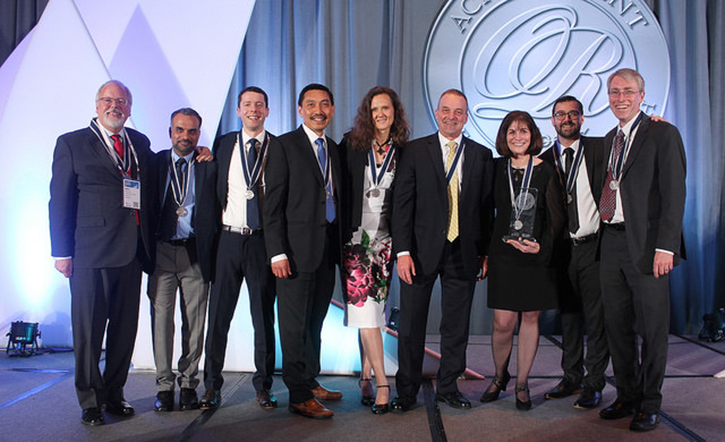
The FCC team that won the Franz Edelman Award for Achievement in Operations Research and Management Science (left to right): Carnegie Mellon's Michael Trick, Dinesh Menon, Tony Coudert, Rudy Sultana, Melissa Dunford, Steve Charbonneau, Karla Hoffman, James Costa, Brian Smith. Photo provided.
If we want driverless cars, George Mason University professor Karla Hoffman said, if we want the internet of things, drones and new medical technologies, the electromagnetic spectrum must be repurposed.
To do that, the Federal Communications Commission (FCC) recently repurposed 84 megahertz of low-frequency spectrum. It did this by purchasing spectrum from the nation’s television broadcasters and auctioning that spectrum to wireless providers. Television stations remaining on the air were reassigned channels within a smaller TV band.
Developing the optimization software and analytics both for the auction and to place 2,990 television stations in the United States and Canada on channels that allow them to reach the same number of viewers was the job of a nine-person team with deep Mason roots, mostly handpicked by Hoffman, a professor of systems engineering and operations research in the Volgenau School of Engineering.
So successful was the four-year project that the FCC team was given the 2018 Franz Edelman Award for Achievement in Operations Research and the Management Sciences. The $10,000 award, the most prestigious in the field, is given annually by the Institute for Operations Research and the Management Sciences.
“It was my dream project with my dream team,” said Hoffman, whose FCC experience and reputation as a leader in the field of mathematical and statistical modeling positioned Mason to have a prominent role in the venture.
The team included Mason graduates Steve Charbonneau, MS Operations Research and Management Science ’95, MS Systems Engineering ’97, PhD Information Technology ’04; James Costa, MS Operations Research ’12; Melissa Dunford, MS Mathematics ’99; and Brian Smith, MS Operations Research ’15.
Also on the team were Hoffman’s former students Dinesh Menon, Tony Coudert and Rudy Sultana, as well as Michael Trick, the Harry B. and James H. Higgins Professor of Operations Research at Carnegie Mellon University in Qatar.
“The auction could not have been possible without operations research,” said John Shortle, professor and chair of Mason’s Systems Engineering and Operations Research Department. “We are proud of the Mason faculty and alumni on the winning team.”
“It does speak volumes about the quality of the [Mason] program,” Costa said. “It obviously prepared people to execute on a massive project that had a huge real-world impact.”
The spectrum auction brought in $20 billion, $7 billion of which went to reducing the federal deficit. Through operations research, and mathematical and computer science techniques, 78 percent of the television stations remained on their same channels after the auction.
“We were worried about all the stations,” Smith said. “If they were moving to a new channel, would they still reach the same population they were broadcasting to before; would they interfere with each other and cause populations to not get their services?”
What to do?
First, Smith said, the physics of the individual television signals were modeled to determine whether stations operating on close to the same channels would interfere with each other. That data was processed into mathematical equations that, with the help of a lot of computer processing power, allowed the team to provide solutions that satisfied the FCC’s goals and overcome all interference constraints.
Get a more detailed look at the process with videos here, here and here.
“We were so excited when the tools and models we developed outperformed all expectations,” Smith said.
“The FCC believed in the project and the team but warned that all the software had to work flawlessly,” Hoffman said. “There would never be a second auction of this type if this one failed. I got to work with my ‘A’ team on an impactful, challenging problem. There can’t be anything better than that.”
